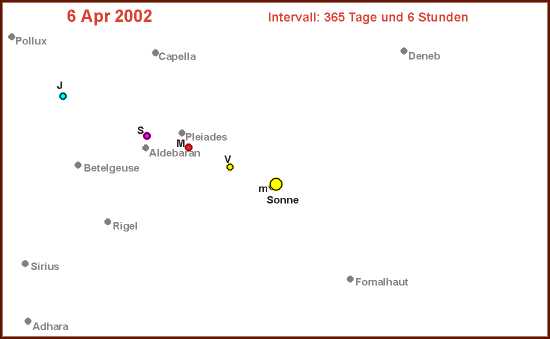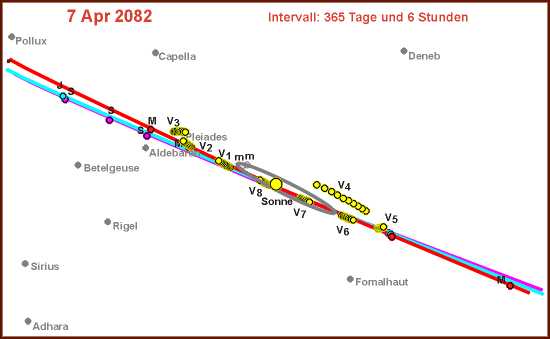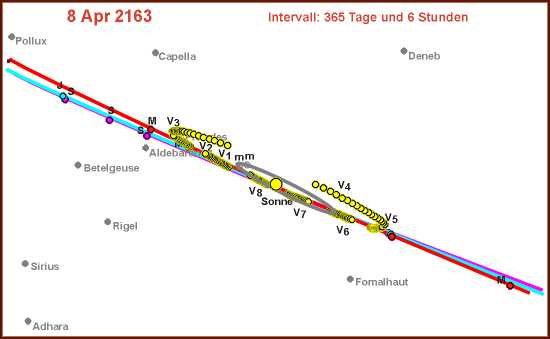(Our suggested observation no. 1; 20 October, 2021)
The Sun and Venus are at least seven billion years old. They emerged simultaneously from the primordial cloud of the Solar System. The Sun has gathered most of the mass of the primordial cloud into itself. Its little brother, the Andrea-star, has attracted most of the remaining mass to itself. From the small remainder of the mass of the primordial cloud, the primordial planets were formed. What fell into the centre of the mass of the whole system during the following billions of years formed into one of these primordial planets, Venus. This means that in reality in our Solar System is not Venus "dancing" around the Sun, but the Sun is "dancing" around Venus. We know all this from our Solar System prehistory.
I have presented several arguments for the correctness of this prehistory in my books, and also in the previous articles of this blog. But, still, a deeper need for a direct observation of this "dance" with "our own eyes" remains, doesn't it? Is such an observation possible? Yes, it is possible, and we discuss it here below. Already 20 years ago, when I first described this possibility, there were available numerous animation programmes of the planetary motion of our Solar System. I used one of them on my PC at the time. The reasoning behind it was the following.
If the Sun were in the centre of mass, we could see the Sun in the same point of the stellar background (the so-called fixed stars) year after year and Venus would appear quite regularly with its orbital period of 224.7 days somewhere on its orbit around the Sun. However, if Venus actually lies at the centre of the Solar System's mass, then the situation changes quite dramatically. We still define the terrestrial year according to the same principle as before; that is, the time interval between two moments when the Sun appears in the same point of the background from our point of view. Venus, however, does not care about our definition, of course. It makes the Sun dance around itself, once with the period of 224.7 days (because of the mass of the Sun itself) and the second time, with the period of 247.19 years (because of the mass of the Dark Companion, which is what I call the remnants of the Andrea-star that are not visible to our eyes). However, since every movement is to be understood relatively, we can also consider the dance of the Sun around Venus as a dance of Venus around the Sun. And it is precisely the slower step of Venus' dance around the Sun that we can observe quite comfortably on our own home computer. All we need is an astrophysical programme that can animate the movement of the planets of the Solar System. What comes out of such an animation is shown in the series of sketches below.

The first of these shows the starting positions of my planetary animation at that time (on 6 April 2002). The relatively immobile cosmic background is marked here by the ten grey coloured dots with the names of the stars, or groups of stars (Pleiades), which lie at a distance of between 8.7 light years (Sirius) and 1600 light years (Deneb) from us. For comparison, we should know that the light from the Sun takes only about 8 minutes to reach the Earth. In this relation, the cosmic background of our animation is indeed (almost) immobile. We start the animation of the planetary motion at any location on Earth and at any time. In my case, this was the sky over Berlin on 6 April 2002. The Sun is placed in the centre of the map. The names of the planets are clear: J -Jupiter, S -Saturn, M - Mars, V- Venus, m - Mercury. It is important that the interval of the animation is set exactly to one year. At the beginning of our animation, little Mercury was hiding behind the Sun. Above all, we diligently record all the positions of Venus year by year. We observe that over the next eighty years certain patterns build up in the planetary motion.
On the next sketch, after eighty years, we have plotted all eighty positions for Venus only. For the rest of the planets we have shown only some of the first positions. The rest of their positions are symbolised by the corresponding lines. Mercury passes through a closed ellipse several times during this period. It is even closer to the Sun than Earth and Venus, so we never see it far from the Sun. The remaining three planets visible to the naked eye, Mars, Jupiter and Saturn, orbit further away than the Earth, so we only see the "open" parts of their orbits behind the Sun.
What interests us here is the distribution of Venus' positions. They are by no means scattered throughout the orbit. Rather, they are grouped in tens in eight sections of the orbit. We have labelled these sections on the following sketch in the order of their visit by Venus with the marks V1 to V8.

Why does the apparent orbit of Venus around the Sun divide into eight sections? The answer lies in the construction of the true orbit of the Earth around the Sun and Venus simultaneously (see after the Rosetta orbit of the Earth). The Earth (with us, the observers of the animation) actually takes eight years to return to the initial position of its orbit. In the intervening years, our true observing position is at seven different points in the solar system. Because of this, the apparent position of Venus (which in reality is stationary because it lies at the centre of the system's mass) slowly shifts. With each passing year, the centre of mass of the Sun's dark companion shifts by about four parts per thousand of its orbit (exactly one in 247.19). Thus, from our observation post on Earth, we see the apparent position of the centre of all mass in Venus also correspondingly shifted on our "egocentric" background of stars determined to the Earth year.
Let us run the animation for another eighty years. After these years, the mass of the Dark Companion has already left about two thirds of its orbit behind. The same applies to the apparent orbit of Venus around the Sun.

The mass of the Dark Companion ends its course around Venus in the following eighty-seven years and returns to the position from 2002, the initial year of our animation. In the same time Venus also returns to its initial position observed by us on Earth. After that, the dance of the two old "ladies", the Sun and Venus, goes on and on into the next revolution, as it has done for seven billion years.

These 247 images of Venus coming together year after year as individual "pearls" to form a "string of pearls" in the sky never fail to impress me. Such behaviour can probably not be explained by any other idea than that of the existence of the Dark Companion's mass. Animation used properly, as we have just seen, can tell an impressive story even without claiming any space probes. And it is certainly cheaper and more accessible to everyone.